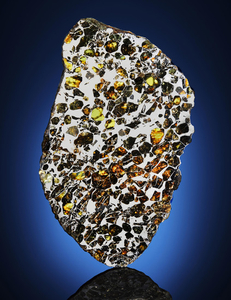EXTRATERRESTRIAL GEMSTONES IN METALLIC MATRIX — A COMPLETE SLICE OF A SEYMCHAN METEORITE, Pallasite – PMG Magadan District, Siberia, Russia
This sample is from the interface of the molten iron core and stony mantle of an asteroid that shattered following a collision with another asteroid. The metallic matrix is highly polished and the highly translucent olivine and peridot crystals range in hue from chartreuse to amber. Modern cutting and polishing.
139 x 81 x 2 mm. (5½ x 3 x ⅛ in.) and 127.3 g.
A complete slice of a meteorite with extraterrestrial gems. Pallasites are not only rare, representing less than 0.2% of all known meteorites, they are also widely considered the most beautiful extraterrestrial substance known. Like all pallasitic meteorites, Seymchan originated from the mantle-core boundary of an asteroid that broke apart following a cataclysmic collision. The crystals seen here are the result of small chunks of an asteroid’s stony mantle becoming suspended in its molten metal core. Cut and polished, the lustrous metallic matrix features crystals of gleaming olivine and peridot (gem-quality olivine) ranging in hues from emerald to amber. It was in the 1960s that the first masses of Seymchan were found in a streambed in a part of Siberia made infamous as the remote location of Stalin’s gulags. Identified as meteorites, they were named Seymchan for a nearby town. Unlike most pallasites, the dispersion of olivine crystals in Seymchan can be varied. The example now offered boasts an aesthetic array of olivine and its gem-quality counterpart, peridot, the birthstone of August.
Christie's would like to thank Dr. Alan E. Rubin at the Institute of Geophysics and Planetary Physics, University of California, Los Angeles for his assistance in preparing this catalog note.
View it on
Sale price
Estimate
Time, Location
Auction House
This sample is from the interface of the molten iron core and stony mantle of an asteroid that shattered following a collision with another asteroid. The metallic matrix is highly polished and the highly translucent olivine and peridot crystals range in hue from chartreuse to amber. Modern cutting and polishing.
139 x 81 x 2 mm. (5½ x 3 x ⅛ in.) and 127.3 g.
A complete slice of a meteorite with extraterrestrial gems. Pallasites are not only rare, representing less than 0.2% of all known meteorites, they are also widely considered the most beautiful extraterrestrial substance known. Like all pallasitic meteorites, Seymchan originated from the mantle-core boundary of an asteroid that broke apart following a cataclysmic collision. The crystals seen here are the result of small chunks of an asteroid’s stony mantle becoming suspended in its molten metal core. Cut and polished, the lustrous metallic matrix features crystals of gleaming olivine and peridot (gem-quality olivine) ranging in hues from emerald to amber. It was in the 1960s that the first masses of Seymchan were found in a streambed in a part of Siberia made infamous as the remote location of Stalin’s gulags. Identified as meteorites, they were named Seymchan for a nearby town. Unlike most pallasites, the dispersion of olivine crystals in Seymchan can be varied. The example now offered boasts an aesthetic array of olivine and its gem-quality counterpart, peridot, the birthstone of August.
Christie's would like to thank Dr. Alan E. Rubin at the Institute of Geophysics and Planetary Physics, University of California, Los Angeles for his assistance in preparing this catalog note.



